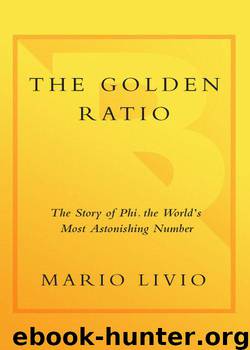The Golden Ratio: The Story of PHI, the World's Most Astonishing Number by Livio Mario

Author:Livio, Mario [Livio, Mario]
Language: eng
Format: epub
Publisher: Random House, Inc.
Published: 2008-11-14T06:00:00+00:00
MELANCHOLY
Another major Renaissance figure who entertained an intriguing combination of artistic and mathematical interests is the German painter Albrecht Dürer.
Dürer is considered by many to be the greatest German artist of the Renaissance. He was born on May 21, 1471, in the Imperial Free City of Nürnberg, to a hardworking jeweler. At age nineteen, he already demonstrated talents and ability as a painter and woodcut designer that surpassed those of his teacher, the leading painter and book illustrator in Nürnberg, Michael Wolgemut. Dürer therefore embarked on four years of travel, during which he became convinced that mathematics, “the most precise, logical, and graphically constructive of the sciences,” has to be an important ingredient of art.
Consequently, after a short stay in Nürnberg, during which he married Agnes Frey, the daughter of a successful craftsman, he left again for Italy, with the goal of expanding both his artistic and mathematical horizons. His visit to Venice in 1494–1495 seems to have accomplished precisely that. Dürer's meeting with the founder of the Venetian School of painting, Giovanni Bellini (ca. 1426–1516), left a great impression on the young artist, and his admiration for Bellini persisted throughout his life. At the same time, Dürer's encounter with Jacopo de' Barbari, who painted the wonderful portrait of Luca Pacioli (Figure 50), acquainted him with Pacioli's mathematical work and its relevance for art. In particular, de' Barbari showed Dürer two figures, male and female, that were constructed by geometrical methods, and the experience motivated Dürer to investigate human movement and proportions. Dürer probably met with Pacioli himself in Bologna, during a second visit to Italy in 1505 to 1507. In a letter from that period, he describes his visit to Bologna as being “for art's sake, for there is one there who will instruct me in the secret art of perspective.” The mysterious “one” in Bologna has been interpreted by many as referring to Pacioli, although other names, such as those of the outstanding architect Donato di Angelo Bramante (1444–1514) and the architectural theorist Sebastiano Serlio (1475–1554), have also been suggested. During the same Italian trip Dürer also met again with Jacopo de' Barbari. This second visit, though, was marked by Dürer's somewhat paranoiac nervousness about harm that might be done to him by artists envious of his fame. For example, he refused invitations to dinner for fear that someone might try to poison him.
Starting in 1495, Dürer showed a serious interest in mathematics. He spent much time studying the Elements (a Latin translation of which he obtained in Venice, although he spoke little Latin), Pacioli's works on mathematics and art, and the important works on architecture, proportion, and perspective by the Roman architect Vitruvius and by the Italian architect and theorist Leon Baptista Alberti (1404–1472).
Dürer's contributions to the history of the Golden Ratio come both in the form of written work and through his art. His major treatise, Unterweisung der Messung mit dem Zirkel und Richtscheit (Treatise on measurement with compass and ruler), was published in 1525 and was one of the first books on mathematics published in German.
Download
This site does not store any files on its server. We only index and link to content provided by other sites. Please contact the content providers to delete copyright contents if any and email us, we'll remove relevant links or contents immediately.
| Applied | Geometry & Topology |
| History | Infinity |
| Mathematical Analysis | Matrices |
| Number Systems | Popular & Elementary |
| Pure Mathematics | Reference |
| Research | Study & Teaching |
| Transformations | Trigonometry |
Modelling of Convective Heat and Mass Transfer in Rotating Flows by Igor V. Shevchuk(6391)
Weapons of Math Destruction by Cathy O'Neil(6142)
Factfulness: Ten Reasons We're Wrong About the World – and Why Things Are Better Than You Think by Hans Rosling(4694)
Descartes' Error by Antonio Damasio(3230)
A Mind For Numbers: How to Excel at Math and Science (Even If You Flunked Algebra) by Barbara Oakley(3217)
Factfulness_Ten Reasons We're Wrong About the World_and Why Things Are Better Than You Think by Hans Rosling(3199)
TCP IP by Todd Lammle(3134)
Fooled by Randomness: The Hidden Role of Chance in Life and in the Markets by Nassim Nicholas Taleb(3044)
Applied Predictive Modeling by Max Kuhn & Kjell Johnson(3018)
The Tyranny of Metrics by Jerry Z. Muller(3000)
The Book of Numbers by Peter Bentley(2908)
The Great Unknown by Marcus du Sautoy(2646)
Once Upon an Algorithm by Martin Erwig(2598)
Easy Algebra Step-by-Step by Sandra Luna McCune(2581)
Lady Luck by Kristen Ashley(2532)
Practical Guide To Principal Component Methods in R (Multivariate Analysis Book 2) by Alboukadel Kassambara(2497)
Police Exams Prep 2018-2019 by Kaplan Test Prep(2483)
All Things Reconsidered by Bill Thompson III(2355)
Linear Time-Invariant Systems, Behaviors and Modules by Ulrich Oberst & Martin Scheicher & Ingrid Scheicher(2333)
